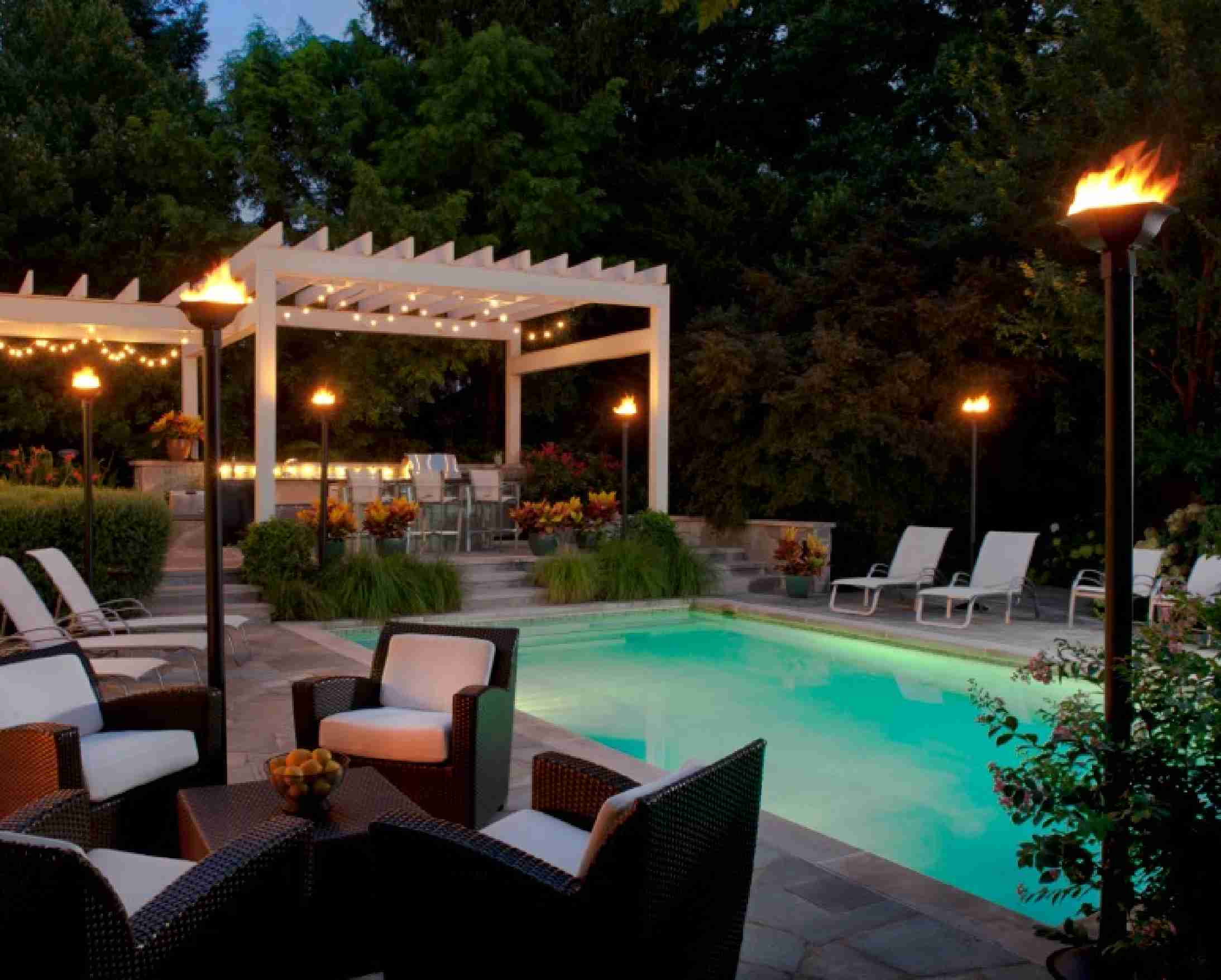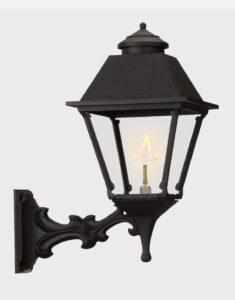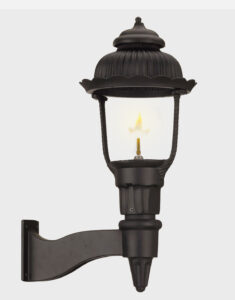How Should You Illuminate Your Space? Here’s Our Guide to Effective Lighting Layout Planning

The right lighting can transform an outdoor space from functional to extraordinary. It can create a mood, set boundaries, add a sense of security, and highlight your property’s best features. Picture the difference between a dimly lit path and one bordered by glowing lanterns. A well-designed lighting plan enhances both the functionality and aesthetic appeal of your outdoor spaces long after the sun sets.
Outdoor lighting design involves a balance of form and function. This guide will walk you through the key considerations for planning and executing a lighting scheme that beautifully illuminates your outdoor areas, and some tips for your indoor rooms, too. Our goal is to help you create a well-lit, inviting, and functional space to enjoy for years to come, for every part of your home.
Table of Contents
The Layers of Lighting
To effectively light a space, consider these three fundamental layers of light:
Ambient Lighting
This layer sets the foundation for your lighting scheme. Ambient light fills the entire space, providing comfortable, general illumination. Think of this as your base level of light that allows you to move around safely and easily. Common examples include ceiling fixtures like chandeliers, flush mounts, and larger pendants. Outdoors, ambient light could come from outdoor fire lanterns, post lights, lanterns mounted on walls, or flood lights positioned to wash a larger area.
Task Lighting
As the name suggests, task lighting provides targeted illumination specifically designed for certain activities. In a kitchen, it might be under-cabinet lighting for food preparation, a pendant over the dining table, or a focused desk lamp in a workspace. Outdoors, you might use adjustable spotlights to highlight a grill area or reading lights on a patio. Task lighting reduces eye strain and increases functionality.
Accent Lighting
This layer adds a dash of drama, highlighting focal points and creating visual interest within a space. Accent lighting can emphasize artwork, architectural features, or textured walls. Examples include track lighting, picture lights, recessed spotlights, or outdoor uplights that illuminate a tree or a piece of statuary. Accent lighting contributes to the mood and overall ambiance of your space.
A well-designed lighting scheme incorporates all three layers in varying degrees. This allows for flexibility as your needs change throughout the day. Remember, a single lighting fixture might provide more than one type of lighting at once. Carefully considering the layers will help you create a beautifully lit space that’s both functional and aesthetically pleasing.
Planning Your Lighting Layout
Now that you understand the layers of lighting, it’s time to create a plan for your space. Here’s how to go about it:
Assess Your Space
Before selecting indoor fixtures and their placement, get familiar with your space. Start with the size and purpose of the room – a cozy den will have different requirements than a sprawling open-concept living area. Then, think about your furniture arrangement, as the placement of beds, couches, and tables will influence your lighting choices. Don’t forget to consider the role of natural light – take note of the direction sunlight enters, its intensity throughout the day, and how your artificial lighting will interplay with it as the sun sets.
Develop a Lighting Plan
The easiest way to visualize your ideas is with a simple sketch. Mark approximate locations where you’d like to install ambient, task, and accent lights. While sketching, try to envision your daily routine and how you use the space. Do you often prepare meals? A well-lit kitchen workspace is key. Do you enjoy relaxing poolside with the occasional night swim? Natural gas torch lights would fit the bill.
Remember, a good lighting plan caters to different activities and moods. If you’re not confident in your drawing skills, consider using free online design tools or apps. These digital tools can help you create a virtual model with different lighting possibilities.
Key Considerations:
- Lighting for Different Areas: Think about the specific needs of each room in your home or outdoor space. In a bedroom, softer ambient light with focused bedside reading lamps creates a relaxing atmosphere. A bathroom needs bright, even illumination around the mirror for grooming tasks. Outdoors, walkways require consistent lighting for safety, while a patio or deck will benefit from a blend of ambient, task, and accent light to create a welcoming space for socializing or dining.
- Switch Placement: Consider how you’ll control your new lighting configuration. Strategically placed switches allow for maximum flexibility and ease of use. A multi-way switch at both ends of a long corridor will prevent fumbling in the dark. Likewise, separate switches for your outdoor path lights and feature lights allow you to illuminate only what’s needed.
- Dimmer Switches: Dimmers offer incredible control over the intensity of your lights. With a simple adjustment, you can change the entire feel of a space. Dim the lights over your dining table for an intimate dinner or turn up the brightness for a lively gathering.
With a thoughtful plan that considers the function, layout, and desired ambiance, you’ll be ready to select the perfect fixtures to illuminate your home.
Choosing the Right Light Fixtures

With your lighting plan in place, it’s time for the fun part – selecting the fixtures that will bring your vision to life. Here are the key factors to consider:
Lighting Function
Perhaps the most important element is ensuring the fixture serves its intended purpose. Think about the type of lighting needed – ambient, task, or accent. For instance, a grand chandelier offers beautiful ambient light in a large foyer, but you’ll want targeted task lighting with under-cabinet lamps for your kitchen countertop.
Lighting Style
Your lighting fixtures should complement and enhance the overall aesthetic of your space. Consider the architectural style of your home as well as your existing decor. Are you drawn to traditional designs with ornate details, or do you prefer a clean and modern approach? Outdoor lighting should also blend seamlessly with the style of your property and its surroundings.
Scale and Proportion
The size of your fixtures needs to be in harmony with the size of your space and the surrounding furniture. An oversized fixture in a small room can feel overwhelming, while an undersized one may get lost. As a general rule of thumb, add the length and width of the room in feet and convert that number to inches. This will give you a good starting point for the approximate maximum diameter of your main light fixture.
Types of Lighting Fixtures: Get acquainted with the vast array of options available to you:
- Pendant Lights: These fixtures hang from the ceiling and offer a blend of ambient and task lighting, depending on size and style.
- Chandeliers: Often decorative and eye-catching, chandeliers provide excellent ambient light for formal spaces.
- Sconces: Ideal for task lighting and accentuating walls, sconces can be found in countless styles and designs.
- Recessed Lighting: Versatile recessed lights can be used for ambient, task, or accent lighting.
- Track Lighting: A customizable solution, track lighting offers flexibility to highlight different areas or artwork.
- Outdoor Lighting: Options include post lights, path lights, lanterns, spotlights, and string lights, each with a unique purpose and aesthetic impact.
Choosing light fixtures is a chance to express your personal style while creating a beautifully illuminated space. Take your time exploring options that meet your functional needs and aesthetic preferences.
Putting it All Together
Now comes the exciting part – transforming your plan into reality! Here are some tips for the installation and finishing touches:
- Installation Tips: For straightforward installations like replacing a single light fixture, confident DIY enthusiasts may be able to handle the project themselves. However, always follow manufacturer instructions and prioritize safety. For more complex installations or if you’re unsure, hiring a qualified electrician is recommended. They can ensure the work is done correctly and up to code.
- Testing and Adjusting: Once your lighting is installed, turn it on and make any necessary adjustments. Look for any overly bright or dim areas and reposition fixtures or change bulb wattages as needed. Pay attention to how the lighting makes the space feel at different times of day and tweak it to achieve the ambiance you desire.
With everything in place, take a moment to admire your newly transformed space! Effective lighting has the power to elevate the look, functionality, and ambiance of your home and outdoor areas.
Conclusion
Crafting an effective lighting layout involves thoughtful consideration of various factors. By layering ambient, task, and accent lighting, you can create both beautiful and functional spaces inside and outside your home. Taking into account the size and purpose of your space, your personal style preferences, and the vast array of lighting fixtures on the market, you’ll transform your home with light.
Remember, a well-lit space ultimately enhances your enjoyment and comfort. Don’t be afraid to experiment with different lighting configurations until you achieve the ambiance that feels perfect for you. With some careful planning, you can create a home and outdoor living area that shines brightly, welcoming you in for years to come.
Frequently Asked Questions
How much light is needed for different rooms? The amount of light needed varies depending on the room’s function. Kitchens and workspaces require brighter light, while bedrooms and living rooms might benefit from softer, layered lighting. Consult online guides for recommended light levels in different rooms.
What type of lighting is best for reading? Focused task lighting is crucial for reading. Look for adjustable lamps with focused beams that eliminate glare and reduce eye strain.
How can I create a warm and inviting atmosphere with lighting? Opt for light bulbs with a warm color temperature (around 2700K-3000K). These create a cozy, yellow-toned light. Dimmers and layers of light also contribute to a welcoming atmosphere.
Do I need to hire a professional to plan my lighting layout? While there’s always value in consulting a lighting designer, many homeowners can successfully create their own plans. Utilize online resources, software tools, and start with a simple sketch to get started.
Ready to transform your space with beautiful and enduring lighting solutions?
American Gas Lamp Works offers the finest handcrafted gas and propane fixtures, along with matching electric options, to elevate the ambiance of your home. From indoor gas lanterns to a huge selection of outdoor gas lamps, our commitment to quality and craftsmanship makes sure that your new lighting will bring warmth, beauty, and functionality to your home for generations.
Explore our extensive collection and find the perfect lighting to illuminate your space.
Contact American Gas Lamp Works today for a free design consultation.
Key Takeaways
- The Importance of Layering: A well-lit space incorporates three layers of light – ambient, task, and accent – to provide both functionality and visual interest.
- Planning is Key: Assess the size, purpose, and furniture arrangement of each space within your home or outdoor areas. Use a sketch or online tools to create a visual plan.
- Function Comes First: Always select lighting fixtures based on their intended purpose (ambient, task, or accent). Factor in the desired style and the appropriate scale and proportion.
- Consider Control: Strategically place light switches for ease of use, and incorporate dimmers for flexible ambiance adjustment.
- The Power of Transformation: Well-designed lighting enhances the functionality, atmosphere, and overall enjoyment of your indoor and outdoor spaces. Don’t be afraid to experiment to find a configuration that suits your needs and style perfectly.
- American Gas Lamp Works Can Help: American Gas Lamp Works offers exceptional quality, handcrafted lighting fixtures for both interior and exterior applications. Their commitment to beauty and lasting construction will elevate your home’s ambiance for years to come.

Author: Patrick Jardini, President
Patrick Jardini is the President of American Gas Lamp Works, a manufacturer and distributor of gas and electric lighting, outdoor heaters, and custom fire bowls. Since purchasing the business, Mr. Jardini has focused on expanding both products and brand awareness through direct sales and strategic partnerships with gas utility providers. Patrick is a Pittsburgh native, Air Force veteran, and MBA graduate from the University of Pittsburgh, and has a professional background in metals production, sales, and marketing.
About Our Blog
Keep up to date on our latest news, lamp and torch technology, and up-coming events.





